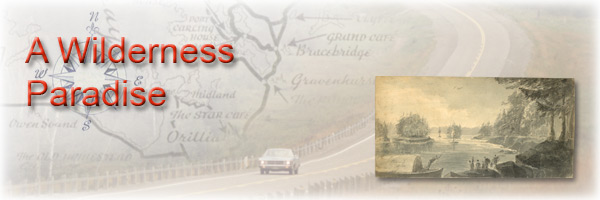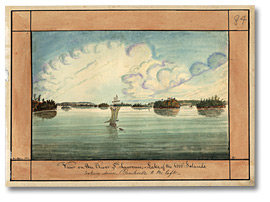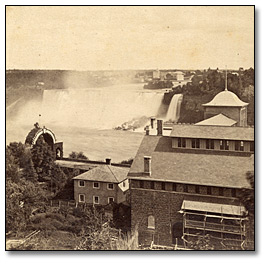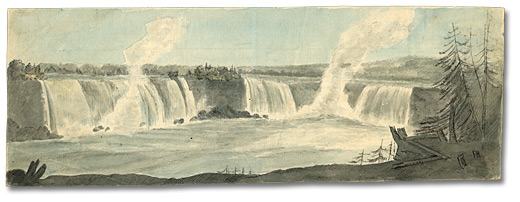
Table of Contents
Home | A Wilderness Paradise | Impact of Improved Transportation: Waterways
Impact of Improved Transportation: The Spread of the Railway
Impact of Improved Transportation: The Lure of the Wilderness
Impact of Improved Transportation: Cottages, Camps and City Parks
Government and the Tourism Industry: Growth of the Park System
Government and the Tourism Industry: Promotion and Infrastructure
Government and the Tourism Industry: Expansion and Diversification
|
Samuel de Champlain and other French explorers were the first to map the land that later became Ontario. As they travelled they noted the diversity of plant and animal life. This map of New France from 1719 has been embellished with the names of animals, insects, fish, birds, trees and fruits of the region.
|
|
|
< |
|
|
After the American Revolution, many Loyalists crossed into British North America and settled in the lands along Lake Ontario and Lake Erie. Many more emigrated from the British Isles in the early 1800s. While these settlers didn't come to see the sights, they could not but be impressed with the magnificence of the St Lawrence River and the great natural wonder of Niagara Falls. Mrs. Elizabeth Simcoe, accompanied her husband John Graves Simcoe on many of his travels through Upper Canada during his years as the lieutenant governor. She described the Falls in her diary as the “grandest sight imaginable” (July 30, 1792). Fortunately, she did not limit her recording of the beauty of Niagara to her diary but camped nearby and painted numerous watercolours that vividly depict the grandeur of the falls. |
|
|
|
|
|
|
|
|
Transportation at that time was most easily done by boat. Most early travellers to Upper Canada came by bateaux, canoe, or Durham boat up the St. Lawrence River from Montreal. After canals were built to bypass the Lachine Rapids, more newcomers arrived by steam-powered vessels. All would be awed by the beauty of the richly wooded and rocky Thousand Islands where the St. Lawrence joins with Lake Ontario. Elizabeth Simcoe passed through the area and drew this scene of islands and bateau near Brockville. |
|
|
|
|
|
Thomas Burrowes was responsible for overseeing the construction of the first canals in Upper Canada. He also documented in watercolours many scenes along the St. Lawrence River including this view of the Islands.
Click to see a larger image (80K)
|

|
|
|
|
|
Within a few years, Niagara Falls was attracting many tourists. Hotels with a panoramic view of the Falls were built in a strip in the area that is now Queen Victoria Park. |
|

|
When Charles Dickens visited in 1841 he stayed on the Canadian side for “ten memorable days” looking at the cataracts from all points of view, including from that of a small ferry boat at the foot of the Falls.
Click to see a larger image (113K)
|
|
|
|
|
However, true tourism – the practice of travelling for pleasure – could not take place in Ontario until there were substantial improvements in transportation. |
|
Home | Next
A Wilderness Paradise | Impact of Improved Transportation: Waterways
Impact of Improved Transportation: The Spread of the Railway
Impact of Improved Transportation: The Lure of the Wilderness
Impact of Improved Transportation: Cottages, Camps and City Parks
Government and the Tourism Industry: Growth of the Park System
Government and the Tourism Industry: Promotion and Infrastructure
Government and the Tourism Industry: Expansion and Diversification
![Carte particulière du Fleuve Saint Louis dressée sur les lieux avec les noms des sauvages du païs, des marchandises qu'on y porte & qu'on en reçoit & des animaux, insectes, poissons, oiseaux, arbres & fruits des parties septentrionales et méridionales de ce païs, [ca. 1719]](pics/4754_saint_louis_map_520.jpg)

![Watercolour: Thousand Islands, July 26, [ca. 1796]](pics/7099_simcoe_1000_isle_520.jpg)
![Photo: Maid of the Mist approaching the landing on the Canadian side, [ca. 1880]](pics/ac15676_maid_mist_520.jpg)